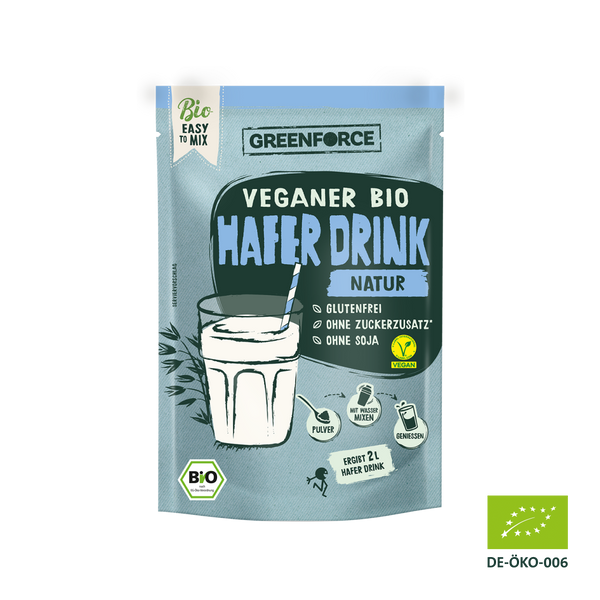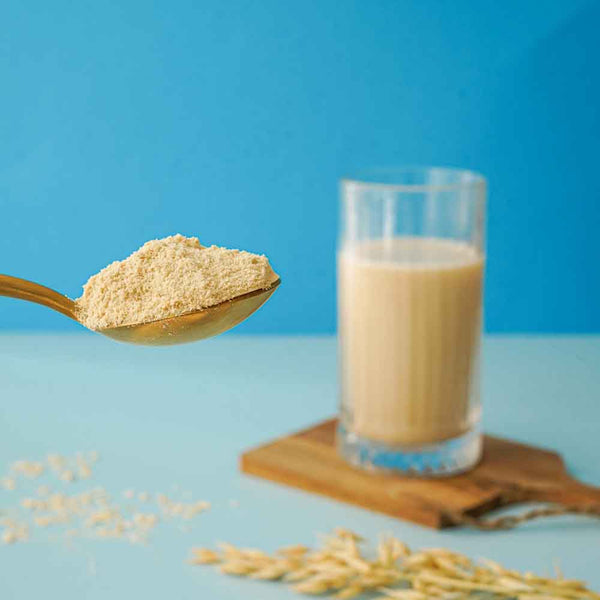Lactose intolerance and weight loss: What you should know about it
Theresa Aicher
12/12/23
Reading time: 8 minutes
Have you lost weight unintentionally and are also suffering from symptoms such as abdominal pain, bloating and diarrhea? Then lactose intolerance could be the reason.
Here at Greenforce we explain how lactose intolerance can lead to weight loss and how you can get the problem under control.
Lactose intolerance - what is it?
Lactose, also known as milk sugar, is a so-called disaccharide. This means that it is made up of two sugar building blocks : dextrose (glucose) and mucus sugar (galactose).
When lactose enters the small intestine, it is normally broken down into the two simple sugars by the enzyme lactase.
In people with lactose intolerance, the body produces too little lactase or no lactase at all. As a result, the split takes place only insufficiently or not at all. This means that the whole lactose reaches the large intestine, where the intestinal bacteria break it down into short-chain fatty acids, lactate, hydrogen and carbon dioxide. This can result in various complaints and sometimes weight loss .
Many people with lactose intolerance do quite well with small amounts of lactose. Small means : no more than 12 grams at a time or a maximum of 24 grams throughout the day. The former corresponds to a portion of 250 milliliters, the latter to half a liter of milk per day.
Lactose intolerance is not an allergy
Lactose intolerance is not a food allergy , but rather an intolerance. In Germany, around 15 to 20 percent of people are affected by it. The number of unreported cases is probably significantly higher.
In contrast, less than five percent of Germans suffer from a cow's milk allergy, in which the immune system reacts to the proteins in cow's milk.
While in the case of an allergy the body reacts to the smallest doses of the respective allergen with typical symptoms such as a runny nose, respiratory problems or gastrointestinal problems, in the case of lactose intolerance certain amounts of milk sugar are individually tolerated.
Symptoms of lactose intolerance
Typical symptoms of lactose intolerance are :
- abdominal pain and cramps,
- a bloated body or flatulence,
- feeling of fullness,
- nausea, sometimes with vomiting,
- intestinal cramps,
- constipation and diarrhea.
In addition, stuck flatulence is a symptom that occurs more frequently in those who have an intolerance to lactose. Lactose intolerance can sometimes cause fatigue , depression, sleep disorders, poor concentration and other non-specific symptoms.
For some of those affected, the symptoms appear immediately after eating foods containing lactose, while for others only hours later.
In addition to the amount of lactose consumed, the following factors also play a role in the severity of the intolerance symptoms:
- the amount of lactase present,
- the composition and quantity of the meal eaten,
- the length of stay in the small intestine and
- the composition and activity of the intestinal flora.
Other influencing factors include antibiotic use, smoking and psychological aspects.
Weight gain is not a direct symptom of lactose intolerance . However, it may be that inadequate processing of lactose triggers processes in the body that promote weight gain.
You can also accumulate a few kilograms if you eat a one-sided diet due to lactose intolerance or if you don't exercise enough because of your symptoms.
Possible consequences and causes of lactose intolerance
If you don't take the symptoms seriously, it can have a detrimental effect on your well-being and health. On the one hand, the acute symptoms can be extremely unpleasant, and on the other hand, they disrupt the absorption of energy and nutrients when eating.
In addition, when you have diarrhea, your body loses a lot of water and excretes what you eat prematurely. This can result in an unhealthy form of weight loss .
In addition, weight loss is promoted if you eat less than normal for fear of new symptoms. Fluid losses due to diarrhea can also force weight loss .
Infants' bodies are designed to survive on milk alone. Therefore, they produce a lot of lactase during breastfeeding in order to be able to break down the lactose contained in breast milk.
During weaning, the digestive system adapts to other foods. In almost 75 percent of the world's population, lactase production decreases during this time. Whether and how much lactose the organism can break down varies from person to person.
If the residual activity of lactase formation is around 50 percent, there are usually no problems. The lower the activity, the higher the intolerance to products containing lactose.
In primary lactose intolerance, those affected still produce sufficient lactose in infancy and toddlerhood. In contrast to lactose intolerance, a baby with a cow's milk allergy shows noticeable symptoms early on.
The bodies of children and adolescents produce increasingly less lactase. As a result, increased symptoms can gradually occur.
If lactase production is disrupted due to an intestinal disease, this is referred to as secondary lactase deficiency. This is the case, for example, with celiac disease and Crohn's disease, but also with bacterial overgrowth or incorrect colonization of the small intestine.
Other possible causes are :
- chemotherapy or radiation therapy,
- a stomach removal (gastrectomy) or
- the (partial) removal of the small intestine.
In such contexts , lactose intolerance can occur at any age .

How is lactose intolerance diagnosed?
At the beginning of the diagnosis there is the so-called omission or diet test . To do this, you avoid all foods and drinks containing lactose for four weeks. If you have fewer or no symptoms during this time, this may be a sign of intolerance.
In order to better assess your symptoms, we recommend keeping a food diary. This way you can easily see which problems you had after which food.
After the four-week abstinence, a stress test follows. To do this, for example, drink half a liter of milk at once and wait to see whether any intolerance symptoms appear.
In addition to this self-test, you should consult a doctor if you suspect lactose intolerance .
It's entirely possible that you have bloating, intestinal cramps, or stomach pain after milk, but not lactose intolerance . These symptoms, like unexplained weight loss , can occur in conjunction with many other medical conditions.
These must be excluded. Your family doctor will usually refer you to a gastroenterology practice. The following tests can shed light on this :
- Breath test : You are given a lactose solution to drink. The hydrogen content in the air you breathe is then measured. This is usually increased if you have lactose intolerance.
- Lactose tolerance test : Here you also drink a lactose solution. Your blood sugar level will be measured before and several times afterwards. This can be used to determine whether your body is able to break down and absorb milk sugar. The measured values alone are not sufficient for a diagnosis. Proof of lactose intolerance is only provided if typical symptoms occur during the tests.
How is lactose intolerance treated?
Before treatment, it must be clarified whether the intolerance is inherited or acquired. In the latter case, the symptoms are the result of another illness. If this is treated successfully, the symptoms usually disappear again.
A diet tailored to lactose intolerance can enable a symptom-free life. The best way to do this is to limit your intake of lactose and only drink milk with other foods . There is currently no therapy that can cure lactose intolerance.
Taking lactase supplements and proper nutrition
Preparations with artificially produced lactase (tablets, capsules, powder or drops) promise to help the intestine break down lactose and thereby make larger amounts of lactose tolerated.
So far, however, there is a lack of meaningful studies that prove that these substances can actually alleviate the typical symptoms. It is also unclear whether prebiotics or probiotics can help.
Basically, the effectiveness of such preparations varies greatly and depends on the individual requirements, dosage and method of intake. It is best to seek advice from your doctor or pharmacy and read the accompanying leaflet.
You don't necessarily need dairy products to eat a balanced diet. But make sure you get enough calcium.
This mineral is found in large quantities, for example in green vegetables such as kale or spinach, as well as in mineral waters containing calcium. Matured cheeses such as old Gouda or Parmesan also contain hardly any lactose and provide a lot of calcium.
Shopping with lactose intolerance
Fresh dairy products are particularly problematic if you have lactose intolerance . You should be careful with mozzarella, cream cheese and mascarpone. It's best to avoid regular cow's milk, ice cream, processed cheese and milk chocolate completely.
In addition to foods that obviously contain lactose, there are some foods that you might not notice at first glance because they contain lactose.
These include, for example :
- Bakery products,
- spreads,
- canned fish and vegetables,
- ready meals,
- ready-made salad dressings,
- spice mixtures,
- muesli and cereals,
- mayonnaise as well
- Pesto.

It's best to get into the habit of always looking at the label when shopping. Milk and products made from it must be listed there. You can save yourself the trouble of checking the list of ingredients if a food is labeled “ lactose-free ”.
Such products contain less than 0.1 grams per 100 grams and are generally well tolerated even by people who are lactose intolerant.
Tip : The terms “ low-lactose ” and “ lactose-free ” are not protected. For advertising purposes, foods that do not naturally contain any lactose are often labeled accordingly. Identical products without such a notice may cost significantly less.
There is this alternative to cow's milk
If you do n't want to do without cow's milk , you can use lactose-free milk. In this case, the lactose contained in it is broken down into glucose and galactose during production. Because these two substances sweeten more than lactose, lactose-free dairy products taste slightly sweeter than regular dairy products.
Other alternatives for cow's milk are plant-based milks such as :
- Soy milk,
- oat milk,
- spelled milk,
- rice milk,
- almond milk or
- Hazelnut milk.
Since soy is one of the six most common foods that can cause allergic reactions in people, soy milk is not entirely recommended. Cereal milks contain carbohydrates but almost no protein. Sugar is often added to nut milks, which means they can be real calorie bombs.
Although you can counteract weight loss , you should enjoy it in moderation for the sake of your health. In addition, these varieties are not suitable for people with nut allergies.
Make sure you get enough calcium
If you choose one of the plant-based versions, you should give preference to products enriched with calcium. This not only prevents unwanted weight loss but also prevents a calcium deficiency .
This would result in your body drawing the calcium it needs for its metabolic processes from your bones and teeth. This could cause them to lose stability and become brittle over time.
To ensure adequate calcium intake, you need three servings of milk and/or dairy products per day. So try out how much you can tolerate and only use the lactose-free substitute products as a supplement. One serving is equivalent to a glass of milk, a cup of yogurt or a slice of cheese.
Adjust your meal plan: This is what you should pay attention to
Milk and milk products naturally supply the body with valuable nutrients such as proteins, minerals, trace elements and vitamins. They also have a positive effect on the intestinal flora and provide enough nutritional value to prevent weight loss .
Instead of giving up the entire range of products containing lactose, you should specifically select well-tolerated dairy products and incorporate them into your diet. This not only makes restaurant visits or invitations much more uncomplicated, but you also ensure a much better quality of life for yourself in the long run.
The following dairy products are generally well tolerated by people who are lactose intolerant :
-
Cheese : The lactose content of cheese depends on the degree of ripeness. The longer the ripening, the less lactose it contains. All ripened varieties are lactose-free. This is not least because a large part of the lactose is removed when the whey is separated. In addition, the bacteria used in the cheese ripening process break down the remaining lactose into glucose and galactose, which they then break down into lactic acid. Hard cheeses such as Emmental or Parmesan and semi-hard cheeses such as Appenzeller or Tilsiter are naturally lactose-free. Soft cheeses such as Camembert or Brie contain at most traces of lactose after ripening and are therefore considered lactose-free.
-
Yogurt and sour milk products : Yoghurt, sour milk products and kefir are well tolerated by most lactose intolerant people. This is due to the so-called fermentation during the manufacturing process. The lactic acid bacteria contained in milk multiply after the addition of bacterial cultures and convert the lactose into lactic acid. Yoghurt therefore contains a third less lactose than in the original product. In addition, the lactase produced by the bacteria supports the digestion of milk sugar. This is why fermented milk products are often well tolerated by people with lactose intolerance .
- Lactose-free dairy products : Many dairies now produce a wide variety of lactose-free products. The selection ranges from milk to quark, yoghurt and cream cheese to cream. You can now also get pizza, ice cream, cakes, chocolate and other milk-based sweets in lactose-free versions.
Lactose intolerance weight loss? Tips for everyday life
The following tips can help you live symptom-free and avoid weight loss despite lactose intolerance.
- Eat dairy products in small portions throughout the day. This way you won't overtax your digestion.
- Allow yoghurt and kefir to ripen until the end of the best-before date. This means that the lactic acid bacteria contained in it have more time to further reduce the milk sugar content.
- By mixing yogurt and kefir with liquid lactate supplements and then refrigerating them for 12 hours, you can also reduce the lactose content.
- Watch out for hidden lactose. This is not only found in food, but also in medicines, for example.
- Lactose is usually better tolerated if you eat foods high in protein or fat at the same time.
Do you already know?
Vegan chocolate cake baking mix
Available: Delivery time 3 - 5 Days
Make your own chocolate and snack on it vegan
Are you a chocolate fan, but the lactose-free varieties are too sweet for you? Then homemade vegan milk or dark chocolate is a good alternative. You can find various vegan recipes for this on the internet, including here at Greenforce .
You create the base mixture from cocoa butter, cocoa powder and a sweetener such as maple syrup, coconut blossom sugar or agave syrup. For milk chocolate you also need some milk powder, for example almond or coconut milk powder.
Depending on your taste, you can add other ingredients such as aromas, spices, seeds or nuts, coconut flakes or crushed cookies to create your very own chocolate creation.
You can make delicious vegan chocolate yourself within 10 to 15 minutes - without lactose and without additives such as waxes, preservatives, palm oil. You can enjoy this treat without having to worry about intolerance symptoms.
How can you get quick relief from symptoms?
If you happen to have too much milk sugar, the following measures can help alleviate the symptoms.
- Stomach pain : If you have a stomach ache, heat (e.g. hot water bottle or cherry stone pillow) can have a soothing effect. For some sufferers, a walk or drinking enough water is good. This stimulates intestinal movement and speeds up digestion. Anticonvulsants with active ingredients such as butylscopolamine are recommended for self-medication. Herbal teas made from chamomile, peppermint, anise, caraway and/or fennel can also provide relief. The same applies to medicines with caraway, angelica, peppermint leaves, licorice root or bitter candytuft.
-
Flatulence : If you have flatulence, you can try heat and fennel or caraway tea. Another option are carminative, flatulence-reducing herbal preparations. When buying, make sure to choose a product without lactose.
- Diarrhea : Frequent diarrhea is one of the main reasons for weight loss if you are lactose intolerant . Reaching out for diarrhea medication without thinking can make the symptoms worse, as these medications often contain lactose. Many manufacturers use lactose as a binding agent to put their active ingredients into tablet form. So ask your pharmacy specifically about lactose-free diarrhea remedies. To balance electrolyte levels, adequate fluid intake is important. Until the diarrhea subsides, you should limit yourself to easily digestible foods such as grated apples, mashed bananas or light soups. This will usually help you get the problem under control quickly and counteract unwanted weight loss.































